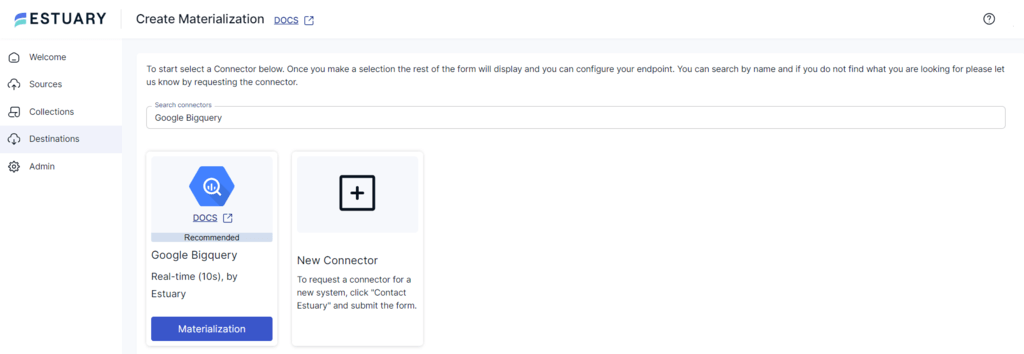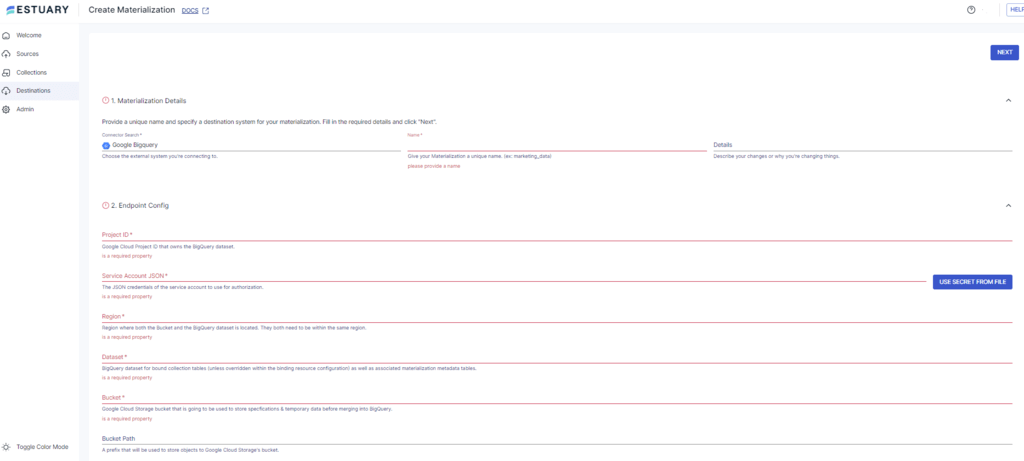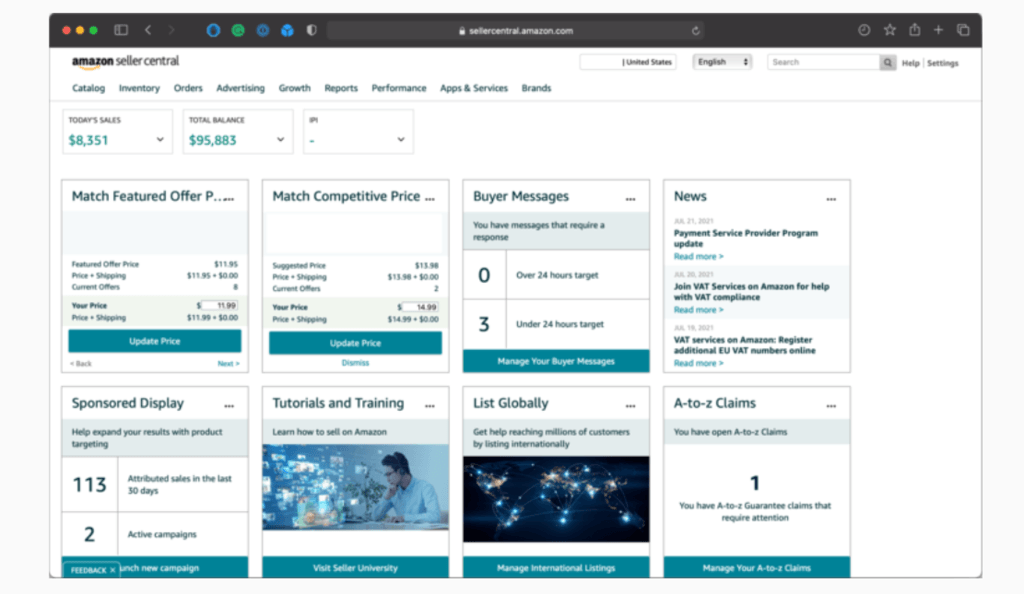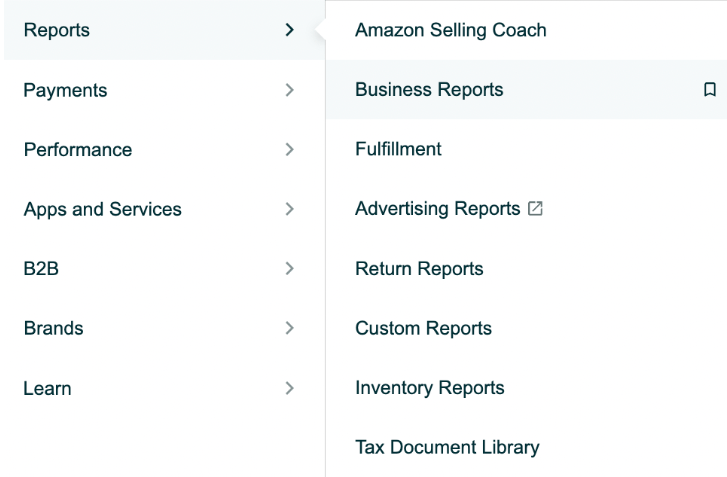
Businesses aiming to optimize their marketing strategies can significantly benefit from analyzing advertising performance. Digital advertising platforms like Amazon Ads offer detailed metrics, including clicks, impressions, and conversions, which are crucial for understanding campaign effectiveness.
Integrating this data into a data warehousing solution like Google BigQuery enables advanced data analytics. With BigQuery’s support for complex querying, scalable analytics, and integrated machine learning tools, you can efficiently analyze your advertising data. This integration facilitates enhanced decision-making, leading to refined advertising campaigns and optimized ad spending.
This article details two methods for efficient data ingestion from Amazon Ads to BigQuery. Let’s start with a quick overview of both platforms. Or if you’re already familiar with both platforms, jump straight down to the implementation steps below.
Amazon Ads – The Source
Amazon Ads is a comprehensive digital advertising service offered by Amazon, designed to help businesses promote their products and services to millions of Amazon customers. The platform provides two primary advertising solutions:
- Amazon PPC (Pay-Per-Click):
- Sponsored Products: Promote individual product listings to appear in search results and product detail pages.
- Sponsored Brands: Showcase your brand and a selection of products in premium placements within search results.
- Sponsored Display Ads: Reach relevant audiences both on and off Amazon with display ads that drive visibility and conversions.
- Amazon DSP (Demand-Side Platform):
- Display Ads: Utilize banner ads to increase brand visibility across Amazon’s network.
- Audio Ads: Engage listeners through audio advertisements on Amazon’s streaming services.
- Video Ads: Capture attention with video content on Amazon’s video platforms.
- Custom Ads: Create tailored advertising solutions to meet specific campaign objectives.
Amazon Ads consolidates all advertising data into detailed advertising reports, providing vital metrics such as click rates, conversion rates, impressions, and costs. These reports are essential for analyzing campaign performance, improving customer experiences, and increasing profitability. By exporting metadata from Amazon Ads, businesses can perform in-depth analyses to understand the impact of advertising efforts on product sales and overall business growth.
Google BigQuery – The Destination
Google BigQuery is a fully managed, serverless data warehouse service that enables businesses to manage and analyze large datasets with ease. Its architecture is specifically designed for cloud computing, ensuring scalability and flexibility to optimize operational performance.
- High Scalability:
- Autoscaling: Dynamically scales resources to handle massive data volumes up to the petabyte scale, ensuring efficient processing without manual intervention.
- Concurrent Processing: Supports high concurrency, allowing multiple users and queries to run simultaneously without performance degradation.
- Built-in ML Integration:
- BigQuery ML: Integrates machine learning capabilities directly within the data warehouse, enabling users to create, train, and deploy machine learning models using standard SQL queries. This facilitates advanced analytics and predictive modeling without the need for external tools.
- BigQuery ML: Integrates machine learning capabilities directly within the data warehouse, enabling users to create, train, and deploy machine learning models using standard SQL queries. This facilitates advanced analytics and predictive modeling without the need for external tools.
- Optimum Cost Management:
- On-Demand Pricing: Pay only for the data processed during query execution, allowing for cost-effective scaling based on actual usage.
- Capacity Pricing: Offers a fixed-price model based on the number of processing slots, providing predictable budgeting for large-scale data operations.
- Advanced Data Processing:
- Complex Querying: Leverage SQL-based querying to perform intricate data analyses, join large datasets, and derive meaningful insights.
- Integration with BI Tools: Seamlessly integrates with various Business Intelligence (BI) tools and data sources, enhancing the ability to visualize and interpret data.
By leveraging all of BigQuery’s features, businesses can perform comprehensive analyses on their Amazon Ads data, enabling data-driven decision-making, optimized advertising strategies, and enhanced return on investment (ROI).
Why Ingest Amazon Ads into BigQuery
- Comprehensive Campaign Performance Analysis: Leverage BigQuery’s advanced querying capabilities to dissect Amazon Ads metrics alongside other business data. This enables you to identify top-performing campaigns, optimize ad spend, and maximize return on investment by making informed decisions based on holistic insights.
- Predictive Analytics and Forecasting: Utilize BigQuery’s integrated machine learning tools to build predictive models that forecast future advertising trends and customer behaviors. This proactive approach allows you to anticipate market shifts, tailor marketing strategies, and stay ahead of the competition with data-driven foresight.
- Unified Data Integration for Enhanced Insights: Combine Amazon Ads data with diverse data sources within BigQuery to create a unified analytics environment. This integration facilitates a deeper understanding of customer journeys, cross-channel effectiveness, and overall business impact, empowering your team to make strategic, data-informed decisions that drive growth and efficiency.
How to Ingest Data from Amazon Ads to BigQuery
- The Automated Way: Using Estuary Flow to Load Data from Amazon Ads to BigQuery
- The Manual Approach: Using Manual Export/Import to Migrate Data from Amazon Ads to BigQuery
Method 1: Using Estuary Flow to Load Data from Amazon Ads to BigQuery
Estuary Flow is an efficient real-time ETL platform that facilitates seamless data integration across diverse data systems.
With its extensive library of 200+ connectors, Estuary enables you to build robust data pipelines. These pipelines can help effectively move data between various sources and destinations. You can utilize this for centralized storage of data, resulting in optimized access and analysis.
Here are some of the prominent features of Estuary Flow:
- Real-time Integration: Estuary facilitates the transfer of data from a source to a destination with millisecond latency. This capability enhances operational efficiency and enables faster decision-making.
- Change Data Capture (CDC): Estuary's CDC feature enables real-time updating of the destination to reflect changes made at the source. This reduces downtime in data ingestion and enhances data consistency.
- No-code Configuration: The no-code configuration feature simplifies setting up and managing data pipelines; you don’t require extensive coding knowledge. This allows you to focus your efforts on other important business management tasks.
These features make Estuary Flow an excellent choice for efficiently loading data from Amazon Ads to BigQuery. Let’s look at prerequisites, followed by steps to use Estuary for this integration.
Prerequisites
Step 1: Configure Amazon Ads as the Source
Here are the steps to configure Amazon Ads as a source in Estuary:
- Log in to your Estuary account or sign up if you do not already have one.
- On the dashboard, click the Sources option from the left pane.
- Now, click the + NEW CAPTURE button on the top left of the Sources page.
- In the Search connectors box, type Amazon Ads. The Amazon Ads connector will appear; click the Capture button of the connector to proceed with its configuration.
- On the Create Capture page, enter the mandatory details, such as Name, Region, Start Date, and Profile IDs. Then, click NEXT > SAVE AND PUBLISH.
The connector will capture your Amazon Ads data via the Amazon Ads API into Flow collections.
Step 2: Configure BigQuery as the Destination
- After setting the source, you will see a pop-up window with the details of the capture. To proceed with setting the destination end of the pipeline, click on MATERIALIZE COLLECTIONS in this pop-up.
Alternatively, navigate to the main dashboard and click on Destinations > + NEW MATERIALIZATION.
- In the Search connectors box, type Google BigQuery. The Bigquery connector will appear; click on the connector’s Materialization button.
- On the Create Materialization page, enter all the required details, such as Name, Project ID, Service Account JSON credentials, Region, Dataset, etc.
- Flow will automatically link the capture of your Amazon Ads data to the BigQuery materialization. However, if it isn’t linked, you can use the Source Collections section to do so.
- Finally, click on NEXT > SAVE AND PUBLISH.
The connector will materialize Flow collections of your Amazon Ads data into BigQuery tables.
This concludes the data ingestion from Amazon Ads to BigQuery using Estuary Flow.
Method 2: Using Manual Export/Import to Ingest Data from Amazon Ads to BigQuery
This method involves manually extracting data from Amazon Ads and importing it into Google BigQuery. Follow these steps to ingest your data without external tools.
Export Data from Amazon Ads
You can extract data from Amazon Ads using either the user interface (UI) or the Amazon Ads API.
A. Export CSV Files Manually via UI
- Access Amazon Seller Central
- Log in to your Amazon Seller Central account.
- Navigate to Reports in the top menu bar.
- Select and Customize Advertising Reports
- From the drop-down menu, choose Advertising Reports.
- Select the desired report type (e.g., Sponsored Products, Sponsored Brands, Sponsored Display).
- Customize the report by selecting the date range (daily, weekly, monthly) and other relevant filters.
- Download CSV Files
- Click the Download button to export the selected report in CSV format.
Note: This method is limited to accessing reports from the past 30 days and offers limited customization options.
B. Export Data Using Amazon Ads API
- Set Up API Access
- Obtain your API credentials from the Amazon Ads platform.
- Use HTTP POST, PUT, and GET requests to create and retrieve report data in JSON format.
- Extract and Download Data
- Customize your API requests to extract specific data records as needed.
- Download the extracted JSON files to your local system.
- Upload to Google Cloud Storage
- Transfer the downloaded JSON files to a Google Cloud Storage (GCS) bucket for staging.
Step 2: Load CSV/JSON Files into BigQuery
- Access Google Cloud Console
- Log in to your Google Cloud Console.
- From the left-hand navigation menu, select BigQuery.
- Create a New Table
- In BigQuery, navigate to your desired dataset.
- Click on Create Table.
- Configure Source Settings
- Source: Choose Google Cloud Storage.
- URI: Enter the path to your CSV or JSON file (e.g., gs://your-bucket/path/to/file.csv).
- File Format: Select CSV or JSON based on your data.
- Define Table Destination
- Dataset: Select the target dataset (e.g., advertising_data).
- Table Name: Enter the desired table name (e.g., amazon_ads_metrics).
- Set Schema and Options
- Schema: Define the table schema or use auto-detection.
- Advanced Options: Configure additional settings like field delimiters for CSV.
- Load the Data
- Click Create Table to initiate the import process.
- Once completed, verify the data by running sample queries in BigQuery.
Step 3: Verify Data Integrity
- Check Loaded Data
- Run sample queries in BigQuery to ensure data has been imported correctly.
- Validate key metrics and data points to confirm accuracy.
- Handle Errors
- If errors occur during the import process, review the error messages in BigQuery.
- Adjust your CSV/JSON files as necessary and re-import the data.
Limitations of Manual Export/Import
- Time-Consuming and Labor-Intensive: Manually exporting and importing CSV files requires significant effort and time, delaying data availability for critical business decisions.
- Increased Risk of Human Error: The manual process is prone to mistakes such as incorrect data formatting and incomplete transfers, which can compromise data integrity.
- Lack of Real-Time Data Synchronization: CSV import/export does not support real-time data updates, resulting in outdated information being used for analysis.
Conclusion
Ingesting data from Amazon Ads to Google BigQuery empowers businesses to perform comprehensive analytics on their marketing campaigns. By leveraging BigQuery’s advanced querying capabilities and scalable infrastructure, organizations can uncover deep insights into campaign performance, optimize ad spend, and refine their marketing strategies for enhanced effectiveness and higher return on investment.
This article outlined two methods for transferring data from Amazon Ads to BigQuery: manual CSV export/import and using the Mixpanel Snowflake connector. While the manual CSV method is straightforward, it introduces challenges such as data latency, increased complexity, and a higher risk of errors, which can impede timely decision-making and affect the accuracy of your analytics.
Estuary Flow offers a superior alternative by automating the data transfer process between Amazon Ads and BigQuery. With its extensive library of connectors, robust automation capabilities, and support for real-time integration, Estuary Flow ensures efficient, accurate, and seamless data synchronization. This not only enhances your data analytics capabilities but also simplifies the workflow for data engineers, allowing them to focus on strategic initiatives rather than managing manual data transfers. By choosing Estuary Flow, your business can achieve real-time insights, improve operational efficiency, and drive sustainable growth through data-driven decision-making.
Sign up for an Estuary account today to utilize its efficient features for effortless data migration!
FAQs
How does integrating Amazon Ads data into BigQuery enhance the effectiveness of marketing strategies?
Integrating Amazon Ads data into Google BigQuery allows businesses to perform comprehensive analyses by combining advertising metrics with other critical business data. This unified approach enables marketers to identify which campaigns drive the most conversions, optimize ad spend based on performance insights, and tailor strategies to target high-value customer segments. By leveraging BigQuery’s advanced querying and machine learning capabilities, organizations can uncover deeper trends and make informed decisions that maximize marketing ROI and drive sustainable growth.
What scalability and performance advantages does BigQuery offer for analyzing Amazon Ads data?
Google BigQuery provides a highly scalable and performant data warehousing solution that can effortlessly handle the large volumes of data generated by Amazon Ads campaigns. Its serverless architecture allows for automatic scaling of compute and storage resources, ensuring consistent query performance even as data grows. This scalability ensures that businesses can run complex, large-scale analyses in real-time, enabling swift adjustments to marketing strategies and enhancing the ability to respond to market dynamics efficiently. Additionally, BigQuery’s parallel processing capabilities reduce query latency, facilitating faster insights and more agile decision-making.
How does automating data ingestion with Estuary Flow improve the reliability and accuracy of Amazon Ads analytics in BigQuery?
Using Estuary Flow to automate the data migration process between Amazon Ads and BigQuery ensures effortless, real-time data synchronization with minimal human intervention. Estuary Flow’s robust Change Data Capture (CDC) technology tracks and replicates data changes instantaneously, maintaining data integrity and reducing the risk of errors associated with manual CSV imports. This automation not only enhances the reliability and accuracy of your analytics but also frees up data engineers to focus on strategic initiatives rather than data management tasks. Consequently, businesses can achieve more consistent and precise insights, enabling better-informed marketing decisions and optimized campaign performance.

About the author
Dani is a data professional with a rich background in data engineering and real-time data platforms. At Estuary, Daniel focuses on promoting cutting-edge streaming solutions, helping to bridge the gap between technical innovation and developer adoption. With deep expertise in cloud-native and streaming technologies, Dani has successfully supported startups and enterprises in building robust data solutions.
Popular Articles

















